Bulgaria

This Balkan country has undergone a multitude of changes for the last thirty years.
Nonetheless, prior to modern time, it was perceived with a number of cliches related to the Soviet era. At present, it is becoming a more and more developed state that welcomes its visitors with bustling holiday spots and retreats.

General Information
Bulgaria is famous for its resorts and benign climate, a large amount of lavender grown (even larger than in French Provence), and rose petal oil, which is considered the best of its kinds produced in the world.
People come here to have a good and inexpensive holiday at the Black Sea resorts and to undergo treatment at numerous thermal springs. Bulgaria has the second-largest amount of them in Europe after Hungary.
Historical Background
Bulgaria is a unique country. It has preserved a 1,500-year-long statehood under the same name.
Its development consists of 10 stages. It commenced in the 7th century with Great Bulgaria and ended in 1990 when the Republic of Bulgaria was proclaimed after the collapse of the socialist bloc.
Initially, there was a union of Proto-Bulgarian tribes with the capital in Phanagoria located on the Taman peninsula at the Kerch Strait.
It existed for a couple of centuries during the life of Khan Kubrat, the founder and ruler of the first Bulgarian state. When he died, his sons inherited the country but could not keep it whole and sound, so it dissolved into several tribes.
One of the Khan’s sons, Asparuh, embarked to the Balkans and founded the First Bulgarian Empire. As time passed, all possessions of constantly quarreling Kubrat’s sons lost their independence and became a part of the Khazar Khaganate.
Bulgarians singled out with their battailous temper: they continually raided the nearby and remote lands. In the 7th century, Bulgarians united with seven Slavic tribes that settled the northern part of modern Bulgaria and made even the Byzantine Empire pay them tributes after its defeat in that war.
In 681, the First Bulgarian Empire emerged. The capital was Pliska, the city still existing in the northeast of the country. After that, the Empire began extending its borders during the course of wars. In the 10th century, the county’s might reached the pinnacle, having gained all Balkan territories and even some parts of Hungary, Albania, Greece, Turkey, and Ukraine.
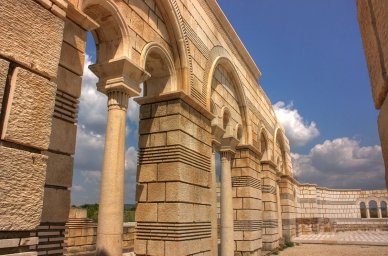
The Great Basilica in Pliska
In 865, Bulgarians joined Orthodox Christianity. The conversion took place owing to the efforts of Boris I, the first Bulgarian ruler who got the title of knyaz (prince). All Bulgarian rulers began to be called ‘tsar’, the word originating from Latin ‘caesar’.
After the adoption of Orthodox Christianity, the country changed the capital into the city of Preslav. However, not only the capital city underwent the changes. The reigns of progressive and ambitious rulers (tsars) during the following several centuries made Bulgaria prosper in all spheres, particularly in the humanitarian field. Bulgarian literature took the leading position within the Slavic directions due to the transition to the Cyrillic script created by Cyril and Methodius.
The wars with Byzantium as an old enemy weakened the Bulgarian state a lot. Eventually, it even ceased to exist for some time and split into several territories under the rule of Byzantines and the Magyars. The attempts to restore independence and wholeness had no result because the rebellions were violently suppressed.
It was the 12th century when the brothers Ivan Asen II and Peter IV of Bulgaria took command of a new war against Byzantium and managed to reclaim the country’s former glory. As a result, they established the Second Bulgarian Empire with Tarnovo as the capital city.

Tarnovo (City of the Tsars) - the historical and cultural capital of Bulgaria
The Empire existed a bit more than 100 years: from 1287 to 1396. The brothers died one after another, and a new tsar Kaloyan ascended the throne. He extended the Bulgarian lands due to successful military campaigns. The resounding defeat of Byzantium by crusaders fostered the military victories of the Bulgarians.
The territories used to be gained and lost during the reign of each Bulgarian ruler till the Ottoman conquest of the Balkans at the end of the 14th century. The Ottoman Empire was so mighty that all efforts of the Bulgarians to restore independence failed. The Turkish Sultans suppressed four revolts.
However, the Ottoman Empire began its fall. Bulgarians had already been recognized as an independent ethnic group till that time. And it gave an impetus to the growth of national identity and the development of the national liberation movement.
Bulgaria gained independence in 1878. Then there were several formations within the territory of the country: Principality of Bulgaria (1879-1908), Third Bulgarian State (1908-1946), and People’s Republic of Bulgaria (1946-1990).
In November 1990, the latter ceased to exist. The country changed its political and economic direction and initiated profound reforms in all spheres of life.
Now it is the Republic of Bulgaria with a population of 7 million people and Sofia as the capital city. Since 2004, Bulgaria has been a NATO member state. In 2007, it joined the European Union.
Geography and Climate
Bulgaria borders Romania, North Macedonia, Serbia, Greece, and Turkey. Besides, the country’s boundaries stretch along the Black Sea, several rivers, and mountain ranges.
Most of the territory constitutes the Balkan mountains with ravines. Forests take approximately one-third of the general area.
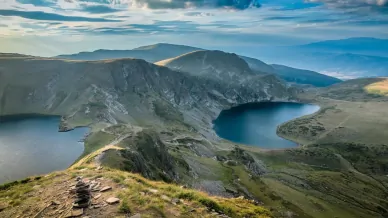
Mountains in Bulgaria
Bulgarian climate undergoes an impact of mountains most of all. They serve a so-called barrier between the northern and southern parts of the country and entail an essential difference in temperatures and precipitations. North is usually colder and rainier than south.
There are continental and Mediterranean climatic zones that tend to interconnect. Thus winters are cold enough with heavy snowfalls, and summers are dry and hot.
The high season in Bulgaria as well as on the entire Black Sea coast takes place between July and September. And the largest tourist influx occurs in August when the water temperature in the sea ranges from +24°C to +28°C.
Ethnic Composition and Language
The Bulgarians constitute a major part of the seven-million Bulgarian population, that is 85%. The second-largest ethnicity is the Turks (9%), and the third position is taken by the gypsies (5%). The rest of the population includes the Russians and Ukrainians - 0.15% and 0.03% respectively.

Bulgarian dancers in traditional costumes
Bulgarians predominantly are Orthodox Christians and make 75% of the population. Nevertheless, only 15% go to church regularly whereas the others consider their religious faith just a formality.
Bulgarian is the official language, and it is also recognized as one of the 24 official languages of the European Union. The EU press is issued in Bulgarian as well.
The largest cities are Sofia (1.4 million people), Plovdiv (385,000 people), and Varna (370,000 people).
The Bulgarian economy is on the middle level of development.
Agriculture, tourism, pharmacy, and the production of cosmetics are the major industries that boost the budget.
Low-cost and well-organised labour enable giant multinationals to locate their enterprises on the territory of Bulgaria. As a result, the level of unemployment has decreased and entailed the budget surplus. Nonetheless, inflation is not stable, which deters Bulgaria as an EU member from introducing the euro. The Bulgarian lev is still the official currency. The EUR-BGN exchange rate is 1:0.51, and the USD-BGN - 1:0.6.
Directions
The most common options for getting to Bulgaria are planes, buses, trains, and cars. Most frequently, tourists travel by plane and train, which is quite fast. There are regular flights.
Travelling by Plane
Air travels are the quickest and most comfortable way to get to Bulgaria. Visitors to the country usually arrive in the biggest airports in Sofia, Varna, and Burgas. A flight from a neighbouring country takes around 1.5-2 hours, and the low-cost price may range from €30 to €50.
Travelling by Bus
A bus trip to Bulgaria is long and tiring and may take from 30 to 38 hours. However, there is an advantage of booking a tour to any Bulgarian city.
Other Options
Another real option is travelling by ferry. Since recently, this kind of getting to Bulgaria has been cancelled, and there is no exact information when it is going to be relaunched.
A trip by car might be the longest and most complicated alternative. You will not get much pleasure from long queues at the customs and the exhaustion of all participants of this tiresome travel.

Accommodation
Everyone who prefers Bulgarian resorts will get a budget-friendly and quality holiday. Tourists are offered the rooms in hotels of various star-rating, small boarding, and guest houses for family rest, hostels, and motels.
- Hostel Mostel is a cosy hostel in Veliko Tarnovo, not far from Tsarevets Fortress. The rooms are clean and comfortable. Free Wi-Fi and breakfast.
- St.St. Constantine and Helena is a two-star hotel in Sandanski, a 40-minute drive from the Pirin National Park and Rozhen Monastery. There are separate bathrooms and toilets, ironing facilities, kettles, and dishware in the rooms.
- Festa Hotel (Albena) offers inexpensive and plainly furnished rooms with separate bathrooms and toilets. It is located a 10-minute walk from Kranevo beach. There is free parking, Wi-Fi, and breakfast.
- Guest House Diamant is a three-star hotel in Sozopol located not far from the Castle of Ravadinovo. The rooms have air-conditioning, bathrooms, toilets, ironing facilities, kettles, and another dishware. There is also free Wi-Fi.
- Family Hotel Romantik is a three-star hotel at Sunny Beach (Slanchev Bryag). There is comfortable furniture, a TV set, and Wi-Fi in each room. There is also a swimming pool.
Big groups of tourists or families with children will favour renting apartments or houses more. The options are available on specialised letting websites.
Places to See
Bulgaria is not only about beaches and resorts with mineral springs. It is also about the multitude of architectural monuments inherited from ancient civilizations. Old monasteries, as pillars of Orthodoxy, arouse an intense interest as well. Besides, the Bulgarian national parks, lakes, and mountains gather hundreds of rave reviews on the Internet.
Sofia
Even though the Bulgarian capital is not as famous for its sightseeing attractions as Paris or Prague, tourists tend to be discovering more and more pleasant sites.
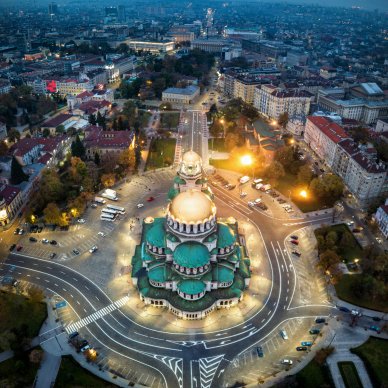
Top view of Sofia, the capital of Bulgaria
The architecture of Sofia has undergone the influence of the centennial rule of the Byzantine and Ottoman Empires. Some of the neighbourhoods resemble Turkish cities. Sometimes there might be a weird feeling like “isn’t it Istanbul or Ankara?” There are the same mosques, hammams, and ancient libraries as in Turkey, just Bulgarian language is spoken everywhere.
Banya Bashi is a mosque constructed in the 6th century on the site of hot thermal springs. It is impossible to establish the reasons and aims: just a construction with a weird name of Banya Bashi (many baths) has remained.
At present, it is just a museum of the Islamic religion. The walls are decorated with white and blue tiles, conventional for the ancient Ottoman mosques, and neat ornamental scripts - quotes from the Quran.
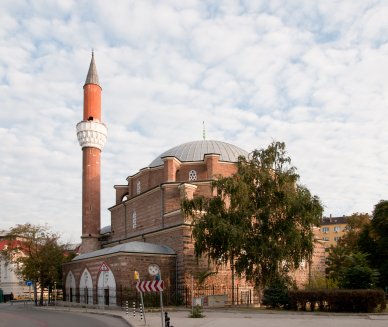
Banya Bashi mosque
The National Archaeological Museum is not a large but very exciting repository of exhibits found at separate times during excavations on the territory of Bulgaria. This country is rich in archaeological finds and takes the third position after Greece and Italy by the number of found items. The old Büyük Mosque, which has been located in the centre of Sofia since the 15th century, houses the museum. There is the presidential palace nearby. The exposition items date back to the Paleolithic age, the times of the Byzantine, and Ottoman eras.
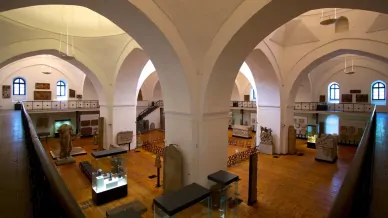
The National Archaeological Museum in Sofia
Alexander Nevsky Cathedral is one of the most beautiful Orthodox churches in the world and the symbol of Sophia. It reminds us of the Bulgarian capital in the same way as the Eiffel Tower reminds us of Paris or Big Ben - of London.
A grand hall holds up to 10,000 believing people. For a good reason, the cathedral is considered one of the biggest Orthodox churches in the world.
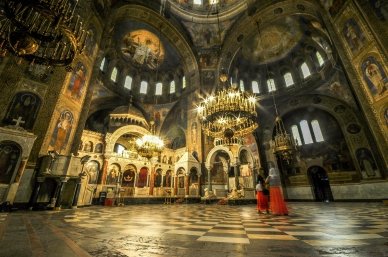
Inside the Alexander Nevsky Cathedral
Serdica is the ruins of an ancient fortress in the suburbs of Sofia. Once, it used to be a powerful fortification of the Thracians, but now there are only several remaining fragments.
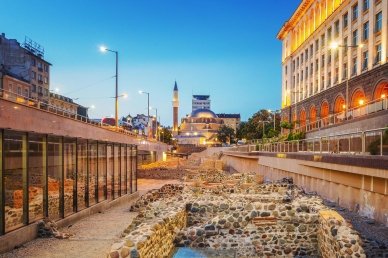
Serdica, Sofia
Nesebar
This city with a population of more than 10,000 people located not far from Burgas attracts travellers from all over the world as one of the most beautiful localities in Bulgaria.
Nesebar New Town constitutes everything related to the resort’s vibrant life: like hotels, guest houses, and restaurants, which are world-famous under the name of Sunny Beach.
Old Town in Nesebar is much more interesting as it is a concentration of all attractions of one of the oldest cities in Europe. It seems that time has stopped there: residential houses built during the 17th and 18th centuries stand opposed each other across the narrow pebbled streets.
Some buildings of the Ottoman era have also been preserved as well as old Orthodox churches and walls of the fortress that used to surround the city.
Nesebar Old Town is a great heritage for humanity, and for a good reason, it has been under UNESCO protection.

Nesebar, Bulgaria
When in Nesebar, you should definitely go on a walking tour of Old Town in order to see the ancient Churches of St. Paraskevi, St. Stephan, Holy Archangels Michael and Gabriel. Just imagine, there are 40 churches and burial vaults constructed by the dynasties of princes and tsars. However, only 10,000 people live here.
The views of the Western Wall of the Fortress bedazzle a lot. Even though there is not so much left from the former might, the ruins remind us of the glorious history of the Bulgarian nation that has endured so many harrowing experiences during its history.
Folk musicians took fancy to a place near the wall long ago. And that is the site of improvised concerts that take place so often. If you want to hear how the Bulgarian bagpipe called gaida sounds, be sure to find some time to attend the fortress ruins.
Byzantine Baths (Thermae) is a gift obtained by Nesebar from the ancient empire. Its powerful statesmen loved to spend their time in the luxurious halls of this giant bath.
The Thermae interior boggles the imagination with marbled floors and columns, stained glass windows, and mosaic pictures.
There are also other enchanting monuments of Ottoman and Byzantine architecture like Turkish baths, a fountain, and amphitheatre.
Messembria Winery is a place where the appraisers of good wines struggle to come. The Bulgarian climate and lands have become a perfect environment for the development of vine growing and wine-making. That is why Bulgarian wines are well-known even abroad.
Visitors to the winery may observe the process of making wine and also taste the end product. They may also buy a couple of bottles to remember the tour to Bulgaria.
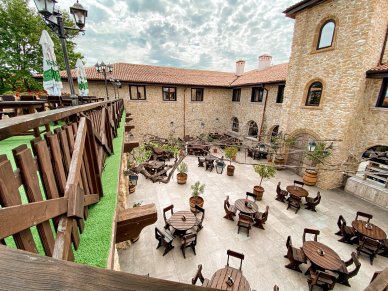
Messembria Winery, Nesebar
Sozopol
This town is very similar to Nesebar, but a bit smaller and older. Sozopol is an ancient town on the Bulgarian Black Sea coast with a population of 6,000 people.
The town is situated 37 km from Burgas and 70 km from Nesebar on a peninsula in the Black Sea. Sozopol streets resemble Nesebar a lot: they are the same narrow, pebbled, and very cosy.
There is also the division into Old and New Town. The older part is full of Medieval charms with antique houses aged around 400 years. The shades of more ancient times may be traced to amphitheatre built in the 2nd century AD.
If a landslide had not taken place in Sozopol in 1972, people would not have known about the Roman amphitheatre. However, after this act of nature, the town residents were stunned with exquisitely preserved tribunes and an arena. Later, this site even became the venue of concerts and town fests.
The other must-see place is the Castle of Ravadinovo designed by the Bulgarian architect Georgi Tumpalov.
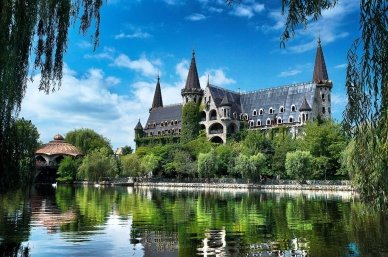
Castle of Ravadinovo, Sozopol
The castle became Georgi’s dream that has come true. He devoted his life to studying castle architecture and then decided to build something like that on his own piece of land.
Though the project has not been finished yet, it has quickly become the most popular place in Ravadinovo and Sozopol. It does not depend on the season or type of weather: the site is always packed with guests. The castle’s magnificence comprises architectural solutions, design, and landscape. There is a good reason that it has obtained the name “In Love with the Wind”. Many couples cannot find a better place for walking and love confessions.
Shipka Pass (Shipchenski Prohod)
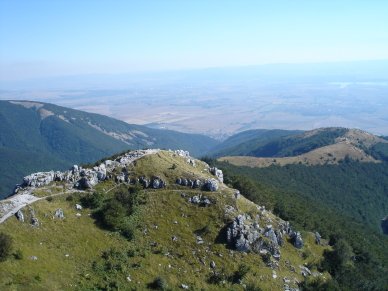
Shipka Pass (Shipchenski Prohod), Bulgaria
Those in love with military history will not stay indifferent to this locality. During 1877-1878, one of the hardest battles of the Russko-Turkish War took place here and ended with the liberation of the Bulgarians from the 400-year Ottoman domination.
However, the pass has a much longer military history. The troops of Alexander the Great had been moving through Shipka during the crusade against the Triballi.
At present, Shipka Pass is a place of mass attendance of tourists keen on the history of battles for Bulgaria and just those who adore walking tours to the mountains.
Food
As well as the entire Balkan cuisine, Bulgarian culinary art is a combination of Turkish and Greek cooking traditions. It also includes some Mediterranean elements. And what is more, it has undergone some impact of the Hungarians, Armenians, and Italians.
The list of the most consumed products in Bulgaria includes much meat, fish and seafood (in seaside regions), vegetables, green stuff, and cheeses.
The hotter the weather, the colder and more lenten the food. In summer, when the temperature reaches +30°C - +32°C, the Bulgarians cook vegetable salads, cold soups, and lean meat.
In winter, they tend to eat thick, fattening and spicy soups, porridges, potato dishes, and meat delicacies. As a rule, many families have the reserves of pickled vegetables and fruit, jams, and brynza made of domestic milk.
Bulgarian cuisine contains many dishes that are widespread in neighbouring countries. For example, there is sarma (a variety of cabbage rolls), rice-stuffed peppers, pilafs, etc.
There are also solely Bulgarian dishes that brightly depict the national uniqueness. This food may be tasted only in Bulgaria or in some variations in all Balkan countries and Turkey.
Kofta and Kebapche
Both dishes originate from Turkey. The recipes were brought by the military chefs of the Ottoman army during the conquest of Bulgaria. Koftas constitute meatballs made of ground mutton or lamb and fried in a deep frying pan.

Kofta
Kebapche is a favourite street fast food. It is a dish of grilled minced meat that can be bought everywhere while walking around the city. Kebapche is usually cooked of mutton or sometimes of pork. Many spices and onions are essential ingredients too.
Moussaka
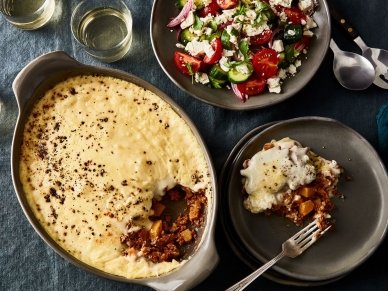
Bulgarian Moussaka
This dish is a visitor from the Middle East. It is a meat-and-vegetable bake with a top layer of egg and milk, which becomes thicker during the baking process and turns into a delicious crackling.
The main ingredients are ground mutton, eggplants, and zucchini cooked in a ramekin or served cut into portions.
Kapama
It is a holiday meal, usually cooked in winter. If you want to taste it, the best time to come to Bulgaria is New Year or Christmas, celebrated on January 7.
As a rule, the process of cooking kapama is complicated. Clay pots and many ingredients are essential. For example, there should be no less than five types of meat like pork, beef, chicken, rabbit, and some variety of ground meat. Nadenica, blood sausage, and sujuk sausages are indispensable elements too.
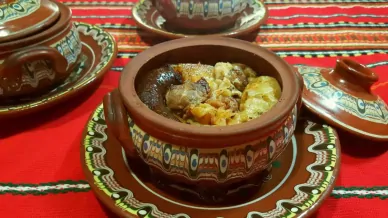
Bulgarian kapama in clay pots
This abundance of meat is also complemented with sauerkraut and spices. All ingredients are put as layers, covered with dough to keep the steam inside, and stewed for five or six hours. As a result, there will be a flavourous, juicy, and tender hotpot.
Pate with Brynza and Nuts
Bulgarians love sandwiches of all varieties. Usually, they are slices of bread spread with pates and pastes. One of them is a typical Bulgarian appetizer called pate with brynza and walnuts.
Cheese is ground together with nuts and complemented with much dill and parsley. Sometimes, sweet pepper may be added. And then there is a thick, filling, and delicious paste that perfectly suits as a snack.
Tarator
This cold yoghurt soup is well-known far beyond Bulgaria owing to thousands of tourists who share the recipe with their friends and relatives after spending a vacation in this country.
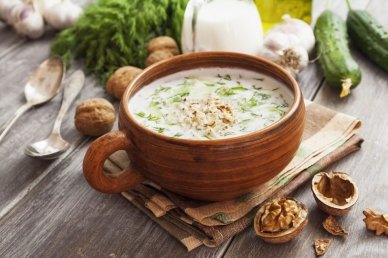
Bulgarian cold yoghurt soup Tarator
The basis for the soup constitutes a mix of fresh cucumbers, scallions, dill, and parsley. Walnuts are ground and fried and then added along with garlic to make the flavour stronger. Then it is necessary to cool ingredients and add the cold youghurt previously diluted with boiled water.
This soup is salvation during the summer heat and the number one dish in the dinner menus of all Bulgarian cafes and restaurants.
Banitsa

Bulgarian Banitsa
This is a marvellous Bulgarian puff pastry filled with brined cheese or meat. The dough is first rolled up into a long roll and then put as a circle into the baking pan to bake till red.
So banitsa is a puff pastry usually served as a dessert if filled with cheese, or as a main course for dinner if it contains meat.
Meat Delicacies
Bulgarians like everything that can be sliced and nicely served as an appetizer. Jerked and smoked meat are perfectly suitable as this kind of delicacies.
Everyone knows basturma, which is air-dried cured beef with spices, or pastrami - brined and smoked beef with pepper and herbs.

Beef basturma
Some other Balkan delicacies originate from Turkey and Arab countries and have taken roots in Bulgaria. For example, these are sujuk and lukanka sausages made of beef and mutton and pork respectively. Garlic, pepper, and herbs are added as well.
When a Bulgarian family celebrates the 18th birthday of their son, they cannot do without cold cuts of lukanka and a glass of beer. It means that a boy becomes an adult and now has a right to drink alcohol with a further snack. Therefore, a plate full of sliced sausage and beer is a treat served for a young man by his parents as a way to recognize his maturity.
Alcoholic Beverages
Spirits are a part of any celebration. What is more, alcohol is always about hard liquors like fruit vodka called rakia of normally 45-60% ABV and mastika - anise liquor of at least 47% ABV. If the percentage is lower, the Bulgarians consider it just like water.
Females usually prefer wines. As has been mentioned before, wine-making in Bulgaria is well-developed. Local varieties of white and red wines are not worse than legendary French and Italian beverages.
When in Bulgaria, try Mavrud - the ancient drink made of red sorts of grapes, Pamid - a perfect red wine, Pelinkovac, and Muscat.
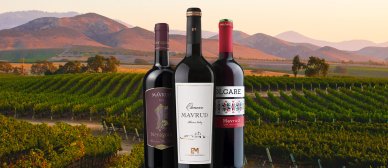
Bulgarian Mavrud
Bulgaria is a country that may be very similar to the Post-Soviet republics at the first glance. However, it is authentic in every aspect, starting with cuisine and ending with architecture. So it is time to get rid of all cliches imposed by the Soviet era in terms of perception of Bulgaria. Now it is an absolutely new country.
FAQ
What is the capital of Bulgaria?
The capital of Bulgaria is Sofia.
How many people live in Bulgaria?
The population of Bulgaria is approximately 7 million people.
What is the official language in Bulgaria?
The official language of Bulgaria is Bulgarian.
What is the Bulgarian currency?
The currency of Bulgaria is the Bulgarian lev (BGN).
What is Bulgaria best known for?
Bulgaria is best known for its rich history, cultural heritage, traditional dances and music, the Black Sea coastline and rose oil production.
Is Bulgaria in the EU?
Yes, Bulgaria is a member of the European Union.
Is Bulgaria part of the Schengen area?
No, Bulgaria is not a part of the Schengen area, but it has applied to join and has been seeking entry.







